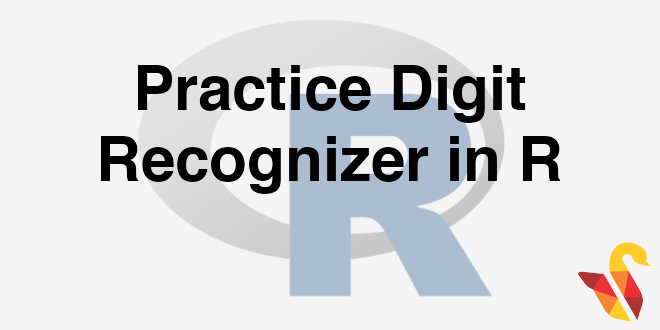
In previous section, we studied about Hidden Layers and Their Roles
As promised in the first post of the series we will build a Neural Network that will read the image of a digit and correctly identify the number.
LAB: Digit Recognizer
- Take an image of a handwritten single digit, and determine what that digit is.
- Normalized handwritten digits, automatically scanned from envelopes by the U.S. Postal Service. The original scanned digits are binary and of different sizes and orientations; the images here have been de slanted and size normalized, resultingin 16 x 16 grayscale images (Le Cun et al., 1990).
- The data are in two zipped files, and each line consists of the digitid (0-9) followed by the 256 grayscale values.
- Build a neural network model that can be used as the digit recognizer.
- Use the test dataset to validate the true classification power of the model.
- What is the final accuracy of the model?
Code: Digit Recognizer
#Importing test and training data
digits_train <- read.table("C:\\Amrita\\Datavedi\\Digit Recognizer\\USPS\\zip.train.txt", quote="\"", comment.char="")
digits_test <- read.table("C:\\Amrita\\Datavedi\\Digit Recognizer\\USPS\\zip.test.txt", quote="\"", comment.char="")
dim(digits_train)## [1] 7291 257col_names <- names(digits_train[,-1])
label_levels<-names(table(digits_train$V1))
#Lets see some images.
for(i in 1:10)
{
data_row<-digits_train[i,-1]
pixels = matrix(as.numeric(data_row),16,16,byrow=TRUE)
image(pixels, axes = FALSE)
title(main = paste("Label is" , digits_train[i,1]), font.main = 4)
}#####Creating multiple columns for multiple outputs
#####We need these variables while building the model
digit_labels<-data.frame(label=digits_train[,1])
for (i in 1:10)
{
digit_labels<-cbind(digit_labels, digit_labels$label==i-1)
names(digit_labels)[i+1]<-paste("l",i-1,sep="")
}
label_names<-names(digit_labels[,-1])
#Update the training dataset
digits_train1<-cbind(digits_train,digit_labels)
names(digits_train1)## [1] "V1" "V2" "V3" "V4" "V5" "V6" "V7" "V8"
## [9] "V9" "V10" "V11" "V12" "V13" "V14" "V15" "V16"
## [17] "V17" "V18" "V19" "V20" "V21" "V22" "V23" "V24"
## [25] "V25" "V26" "V27" "V28" "V29" "V30" "V31" "V32"
## [33] "V33" "V34" "V35" "V36" "V37" "V38" "V39" "V40"
## [41] "V41" "V42" "V43" "V44" "V45" "V46" "V47" "V48"
## [49] "V49" "V50" "V51" "V52" "V53" "V54" "V55" "V56"
## [57] "V57" "V58" "V59" "V60" "V61" "V62" "V63" "V64"
## [65] "V65" "V66" "V67" "V68" "V69" "V70" "V71" "V72"
## [73] "V73" "V74" "V75" "V76" "V77" "V78" "V79" "V80"
## [81] "V81" "V82" "V83" "V84" "V85" "V86" "V87" "V88"
## [89] "V89" "V90" "V91" "V92" "V93" "V94" "V95" "V96"
## [97] "V97" "V98" "V99" "V100" "V101" "V102" "V103" "V104"
## [105] "V105" "V106" "V107" "V108" "V109" "V110" "V111" "V112"
## [113] "V113" "V114" "V115" "V116" "V117" "V118" "V119" "V120"
## [121] "V121" "V122" "V123" "V124" "V125" "V126" "V127" "V128"
## [129] "V129" "V130" "V131" "V132" "V133" "V134" "V135" "V136"
## [137] "V137" "V138" "V139" "V140" "V141" "V142" "V143" "V144"
## [145] "V145" "V146" "V147" "V148" "V149" "V150" "V151" "V152"
## [153] "V153" "V154" "V155" "V156" "V157" "V158" "V159" "V160"
## [161] "V161" "V162" "V163" "V164" "V165" "V166" "V167" "V168"
## [169] "V169" "V170" "V171" "V172" "V173" "V174" "V175" "V176"
## [177] "V177" "V178" "V179" "V180" "V181" "V182" "V183" "V184"
## [185] "V185" "V186" "V187" "V188" "V189" "V190" "V191" "V192"
## [193] "V193" "V194" "V195" "V196" "V197" "V198" "V199" "V200"
## [201] "V201" "V202" "V203" "V204" "V205" "V206" "V207" "V208"
## [209] "V209" "V210" "V211" "V212" "V213" "V214" "V215" "V216"
## [217] "V217" "V218" "V219" "V220" "V221" "V222" "V223" "V224"
## [225] "V225" "V226" "V227" "V228" "V229" "V230" "V231" "V232"
## [233] "V233" "V234" "V235" "V236" "V237" "V238" "V239" "V240"
## [241] "V241" "V242" "V243" "V244" "V245" "V246" "V247" "V248"
## [249] "V249" "V250" "V251" "V252" "V253" "V254" "V255" "V256"
## [257] "V257" "label" "l0" "l1" "l2" "l3" "l4" "l5"
## [265] "l6" "l7" "l8" "l9"#formula y~. doesn't work in neuralnet function
model_form <- as.formula(paste(paste(label_names, collapse = " + "), "~", paste(col_names, collapse = " + ")))
#Lets keep an eye on runtime
pc <- proc.time()
library(neuralnet)
Digit_model<-neuralnet(model_form, data=digits_train1, hidden=15,linear.output=FALSE)
summary(Digit_model)## Length Class Mode
## call 5 -none- call
## response 72910 -none- logical
## covariate 1866496 -none- numeric
## model.list 2 -none- list
## err.fct 1 -none- function
## act.fct 1 -none- function
## linear.output 1 -none- logical
## data 268 data.frame list
## net.result 1 -none- list
## weights 1 -none- list
## startweights 1 -none- list
## generalized.weights 1 -none- list
## result.matrix 4018 -none- numericproc.time() - pc## user system elapsed
## 133.61 0.80 138.75#######Prediction on holdout data
test_predicted<-data.frame(compute(Digit_model,digits_test[,-1])$net.result)
########Collating all labels into a single column
pred_label<-0
for(i in 1:nrow(test_predicted))
{
pred_label[i]<-which.max(apply(test_predicted[i,],MARGIN=2,min))-1
}
test_predicted$pred_label<-pred_label
###Confusion Matrix and Accuracy
library(caret)## Loading required package: latticeconfuse<-confusionMatrix(test_predicted$pred_label,digits_test$V1)
confuse## Confusion Matrix and Statistics
##
## Reference
## Prediction 0 1 2 3 4 5 6 7 8 9
## 0 345 0 5 6 3 6 0 0 3 0
## 1 0 248 0 0 1 0 0 0 1 0
## 2 5 2 170 8 9 5 4 1 3 0
## 3 1 2 1 129 0 7 0 0 3 0
## 4 2 5 12 1 166 3 4 5 5 5
## 5 1 1 0 16 2 132 5 0 5 2
## 6 3 5 3 0 2 1 156 0 0 0
## 7 0 1 1 0 3 0 0 133 2 4
## 8 1 0 6 5 3 4 1 2 143 2
## 9 1 0 0 1 11 2 0 6 1 164
##
## Overall Statistics
##
## Accuracy : 0.8898854
## 95% CI : (0.8753677, 0.9032526)
## No Information Rate : 0.1788739
## P-Value [Acc > NIR] : < 0.00000000000000022204
##
## Kappa : 0.8763343
## Mcnemar's Test P-Value : NA
##
## Statistics by Class:
##
## Class: 0 Class: 1 Class: 2 Class: 3 Class: 4
## Sensitivity 0.9610028 0.9393939 0.85858586 0.77710843 0.83000000
## Specificity 0.9860437 0.9988526 0.97954671 0.99239544 0.97675706
## Pos Pred Value 0.9375000 0.9920000 0.82125604 0.90209790 0.79807692
## Neg Pred Value 0.9914582 0.9908936 0.98444444 0.98015021 0.98110061
## Prevalence 0.1788739 0.1315396 0.09865471 0.08271051 0.09965122
## Detection Rate 0.1718984 0.1235675 0.08470354 0.06427504 0.08271051
## Detection Prevalence 0.1833582 0.1245640 0.10313901 0.07125062 0.10363727
## Balanced Accuracy 0.9735232 0.9691232 0.91906628 0.88475194 0.90337853
## Class: 5 Class: 6 Class: 7 Class: 8
## Sensitivity 0.82500000 0.91764706 0.90476190 0.86144578
## Specificity 0.98267461 0.99237888 0.99408602 0.98696361
## Pos Pred Value 0.80487805 0.91764706 0.92361111 0.85628743
## Neg Pred Value 0.98480738 0.99237888 0.99248524 0.98750000
## Prevalence 0.07972098 0.08470354 0.07324365 0.08271051
## Detection Rate 0.06576981 0.07772795 0.06626806 0.07125062
## Detection Prevalence 0.08171400 0.08470354 0.07174888 0.08320877
## Balanced Accuracy 0.90383730 0.95501297 0.94942396 0.92420469
## Class: 9
## Sensitivity 0.92655367
## Specificity 0.98797814
## Pos Pred Value 0.88172043
## Neg Pred Value 0.99286107
## Prevalence 0.08819133
## Detection Rate 0.08171400
## Detection Prevalence 0.09267564
## Balanced Accuracy 0.95726591confuse$overall## Accuracy Kappa AccuracyLower AccuracyUpper AccuracyNull
## 0.8898854011 0.8763342842 0.8753676969 0.9032525591 0.1788739412
## AccuracyPValue McnemarPValue
## 0.0000000000 NaN- The next post is about Neural Networks Conclusion.




